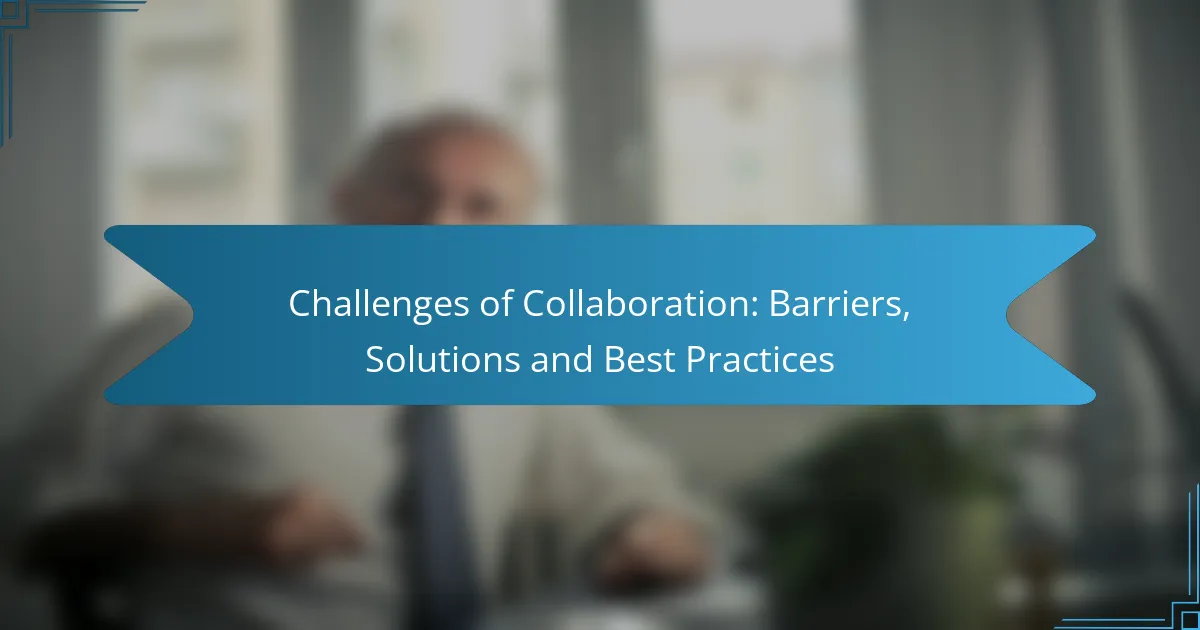Collaboration is essential for successful teamwork, yet it often faces significant challenges such as communication barriers, cultural differences, and technology limitations. To foster a productive environment, teams must proactively identify these obstacles and implement strategies like clear communication practices and inclusive team-building activities. By embracing best practices, organizations can enhance collaboration, boost productivity, and minimize misunderstandings.

What Are the Main Challenges of Collaboration in the UK?
The main challenges of collaboration in the UK include communication barriers, cultural differences, technology limitations, time zone issues, and resource allocation. These obstacles can hinder effective teamwork and project success, making it essential to identify and address them proactively.
Communication barriers
Communication barriers often arise from differences in language proficiency, jargon, or varying communication styles. In a diverse team, misunderstandings can lead to frustration and decreased productivity. To mitigate these issues, establish clear communication protocols and encourage open dialogue among team members.
Regular check-ins and feedback sessions can help clarify expectations and ensure everyone is on the same page. Utilizing visual aids and collaborative tools can also enhance understanding and reduce miscommunication.
Cultural differences
Cultural differences can significantly impact collaboration, as team members may have varying values, work ethics, and approaches to conflict resolution. Understanding and respecting these differences is crucial for fostering a cohesive team environment. Training sessions on cultural awareness can help bridge gaps and promote inclusivity.
Encouraging team-building activities that celebrate diverse backgrounds can also strengthen relationships and improve collaboration. Recognizing and valuing each member’s unique perspective can lead to more innovative solutions.
Technology limitations
Technology limitations can hinder collaboration, especially if team members lack access to essential tools or software. In the UK, ensuring that all team members have the necessary technology and training is vital for seamless collaboration. Regularly assess the tools being used and seek feedback to identify any gaps.
Investing in reliable communication platforms and project management tools can streamline workflows and enhance collaboration. Consider conducting training sessions to familiarize team members with these technologies to maximize their effectiveness.
Time zone issues
Time zone issues can complicate collaboration, particularly for teams spread across different regions. In the UK, coordinating meetings and deadlines can be challenging when team members are in various time zones. Establishing a shared calendar that highlights each member’s working hours can help mitigate scheduling conflicts.
Consider rotating meeting times to accommodate different time zones, ensuring that no one team member consistently bears the burden of inconvenient hours. Asynchronous communication tools can also facilitate collaboration without requiring everyone to be online simultaneously.
Resource allocation
Resource allocation challenges can arise when team members do not have access to the necessary tools, budget, or personnel to complete tasks effectively. In the UK, it’s essential to ensure that resources are distributed equitably among team members to avoid burnout and frustration. Regularly review project requirements and adjust resource allocation as needed.
Implementing a transparent resource management system can help identify shortages and allow for timely adjustments. Encourage team members to voice their needs and concerns regarding resource allocation to foster a supportive working environment.

How Can Teams Overcome Collaboration Barriers?
Teams can overcome collaboration barriers by establishing clear communication practices, leveraging technology, promoting inclusivity, and engaging in team-building activities. These strategies help to create an environment where collaboration thrives, leading to improved productivity and morale.
Implementing clear communication protocols
Clear communication protocols are essential for effective collaboration. Teams should define how information is shared, including the preferred channels (email, chat, meetings) and response times. For example, setting a rule that all team members respond to emails within 24 hours can enhance accountability.
Consider creating a communication guide that outlines these protocols. This guide can include templates for common messages, escalation paths for urgent issues, and guidelines for virtual meetings to ensure everyone is on the same page.
Utilizing collaboration tools like Slack
Collaboration tools such as Slack facilitate real-time communication and project management. These platforms allow teams to create channels for specific topics, share files instantly, and integrate with other tools like Google Drive or Trello. This integration can streamline workflows and reduce the time spent searching for information.
When choosing collaboration tools, consider the team’s size and specific needs. For smaller teams, free versions of these tools may suffice, while larger organizations might benefit from premium features that enhance security and user management.
Fostering a culture of inclusivity
Creating a culture of inclusivity encourages diverse perspectives and enhances collaboration. Teams should actively seek input from all members, ensuring that everyone feels valued and heard. Regularly soliciting feedback can help identify barriers to participation and address them promptly.
Implementing practices such as anonymous surveys or rotating meeting facilitators can promote inclusivity. These strategies encourage quieter team members to share their ideas without fear of judgment, leading to richer discussions and innovative solutions.
Regular team-building activities
Regular team-building activities strengthen relationships and improve collaboration. These activities can range from informal social gatherings to structured workshops focused on problem-solving. Aim for a mix of activities that cater to different interests and preferences to engage all team members.
Consider scheduling team-building events quarterly, allowing time for team members to bond outside of work tasks. Activities like escape rooms, cooking classes, or volunteer days can foster teamwork and enhance communication skills, ultimately benefiting collaboration efforts.

What Are the Best Practices for Effective Collaboration?
Effective collaboration hinges on clear communication and structured processes. By implementing best practices, teams can enhance productivity and minimize misunderstandings.
Setting clear goals and objectives
Establishing clear goals and objectives is fundamental for effective collaboration. Teams should define specific, measurable, achievable, relevant, and time-bound (SMART) goals to ensure everyone is aligned.
For example, instead of a vague goal like “improve sales,” a clear objective would be “increase sales by 15% over the next quarter.” This clarity helps team members understand their roles and contributions.
Establishing regular check-ins
Regular check-ins are crucial for maintaining momentum and addressing issues promptly. Scheduling weekly or bi-weekly meetings allows team members to discuss progress, share updates, and identify roadblocks.
These meetings should be structured with a clear agenda to maximize efficiency. Consider using a rotating facilitator to keep everyone engaged and accountable.
Encouraging feedback and open dialogue
Encouraging feedback and open dialogue fosters a collaborative environment where team members feel valued. Create a culture where constructive criticism is welcomed and appreciated.
Utilize tools like anonymous surveys or suggestion boxes to gather input. Regularly ask for feedback on processes and team dynamics to continuously improve collaboration.
Leveraging project management software
Project management software can significantly enhance collaboration by centralizing communication and tracking progress. Tools like Trello, Asana, or Monday.com help teams organize tasks, set deadlines, and monitor workloads.
Choose software that fits your team’s size and complexity. Ensure all members are trained on the platform to maximize its benefits and avoid confusion.

What Tools Enhance Collaboration in the Workplace?
Effective collaboration in the workplace can be significantly enhanced by using the right tools. These tools facilitate communication, project management, and real-time collaboration, making teamwork more efficient and organized.
Microsoft Teams
Microsoft Teams is a comprehensive collaboration platform that integrates chat, video conferencing, and file sharing. It allows teams to create dedicated channels for specific projects, making it easier to keep discussions organized and accessible.
Consider using Teams for its seamless integration with other Microsoft 365 applications, which can streamline workflows. However, be mindful of potential information overload; establish clear guidelines on channel usage and notifications to maintain focus.
Trello
Trello is a visual project management tool that uses boards, lists, and cards to help teams organize tasks. Each card can represent a task, allowing team members to track progress and deadlines easily.
Utilize Trello for its flexibility in managing various types of projects, from simple to complex. To maximize its effectiveness, regularly update cards and encourage team members to comment and attach relevant files to keep everyone informed.
Asana
Asana is designed for task and project management, enabling teams to assign tasks, set deadlines, and track progress. Its user-friendly interface allows for easy navigation and collaboration among team members.
When using Asana, take advantage of its reporting features to monitor project timelines and workloads. Ensure that all team members are trained on the platform to avoid confusion and enhance productivity.
Zoom
Zoom is a widely used video conferencing tool that supports virtual meetings, webinars, and screen sharing. It is particularly beneficial for remote teams, allowing for real-time communication regardless of location.
To make the most of Zoom, schedule regular check-ins and utilize breakout rooms for smaller group discussions. Be aware of potential technical issues; encourage participants to test their audio and video settings before meetings to ensure a smooth experience.

What Role Does Leadership Play in Collaboration?
Leadership plays a crucial role in fostering collaboration by setting the tone and direction for teamwork. Effective leaders create an environment that encourages open communication, trust, and shared goals among team members.
Providing direction and vision
Leaders must articulate a clear vision that aligns with the team’s objectives, guiding members toward a common goal. This direction helps to unify efforts and ensures that everyone understands their role within the larger context.
To provide effective direction, leaders should regularly communicate the vision and adjust it as necessary based on team feedback and changing circumstances. This adaptability can enhance engagement and commitment among team members.
Practical steps include holding regular meetings to discuss progress and challenges, using visual aids to illustrate goals, and encouraging team input to refine the vision. By doing so, leaders can foster a collaborative atmosphere where everyone feels invested in the outcome.



